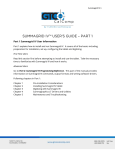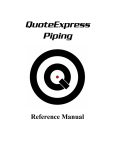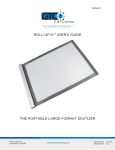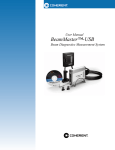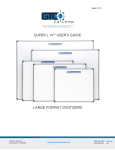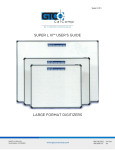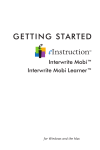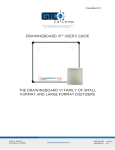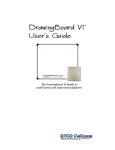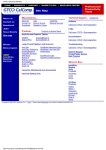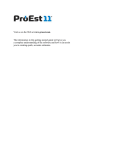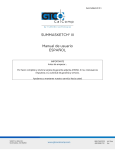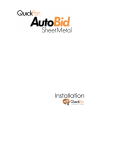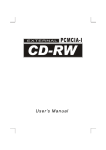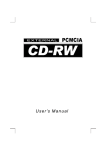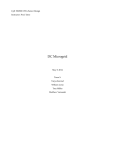Download SummaSketch III Printable Help Files
Transcript
SummaSketch III 1 Table of Contents Overview About this Manual Installing the Tablet Caring for the Tablet Changing the Stylus Tips Guidelines for Installing the Drivers/Utilities Summagraphics Drivers Autodesk Application Drivers MM/SS Format Drivers UIOF/Microgrid Format Drivers Summagraphics Tablet Driver/Mouse Emulator MM/SS Format Drivers UIOF/Microgrid Format Drivers Summagraphics Utilities Resetting the Tablet (MMRST and UIOFRST) MMRST Command UIOFRST Command Testing the Tablet (MMTEST) MMTEST Tablet Test Utility Changing Tablet Formats (MM.COM, UIOF.COM, SEND.COM) MM Tablet Configuration Utility UIOF Tablet Configuration Utility SEND Tablet Configuration Utility Appendices A: What to do if a Problem Arises B: MM/SummaSketch Format Command Summary C: UIOF/Microgird Format Command Summary D: TABLET.COM & TABLETMG.COM Command Options Cursor/Stylus Button Mapping Options Tracking Options Memory Location Options /U, /E, /H1 E: Configuring AutoCAD Rel. 12 for Windows 3 3 5 5 6 6 6 6 6 10 13 13 15 17 17 17 18 19 19 20 20 21 22 23 23 24 26 29 29 29 31 31 SummaSketch III 2 Configuring AutoCAD for Windows Digitizer Mode vs. Mole Mode F: Interface/Power Cable Pin Assignments G: 9- to 25-Pin Serial Adapter Wiring Diagram H: Communication Parameters Regulatory Statements and Warranty Radio and Television Interference Canada European Union Emission Directive European Union WEEE Directive Warranty for U.S./ Canada 31 33 34 34 35 38 38 38 39 39 40 SummaSketch III 3 About this Manual Overview This manual is your guide to using SummaSketch tablet and the SummaSketch Drivers/Utilities software. It assumes you have experience with basic DOS tasks such as changing directories, copying files and creating batch files. If you are unfamiliar with any of these tasks, refer to a DOS user’s manual before continuing. Introduction Below is information to get you acquainted with your new SummaSketch tablet. What are the SummaSketch tablet formats? Your tablet can operate in either of two formats: MM/SummaSketch Format UIOF/Microgrid Format Your tablet automatically defaults to one of these formats, depending on which stylus or cursor is attached when the tablet is powered up. If you have a: Stylus 4-button cursor 16-button cursor Then your default tablet format is: MM/SummaSketch MM/SummaSketch UIOF/Microgrid How do I change between formats? Change stylus or cursor and repower the tablet. Use the software utilities provided on the SummaSketch Drivers/Utilities diskette to override the default tablet formats. What are the SummaSketch drivers? A SummaSketch driver is a program that lets the SummaSketch tablet communicate with your application. For the tablet to act as an input device, it must be able to communicate with the software. A driver converts tablet data into information that can be read, understood and used by your application. SummaSketch III 4 Are there separate drivers for the different tablet formats? Drivers are written for specific tablet formats and work with these tablet formats only. Be sure to select the proper driver within the application software to match the tablet format. What are the SummaSketch Utilities? The SummaSketch Utilities allow you to do the following: Reset the tablet without turning the power on and off. Switch between MM and UIOF formats. Test the tablet to ensure that it is working properly. When do I need to use the Utilities? To reset the tablet. You may need to reset the tablet when switching between some applications. Applications configure the tablet for their own needs. Using one of the tablet reset utilities – MMRST (used with tablets configured for MM/SummaSketch format) or UIOFRST (used with tablets configured for UIOF/Microgrid format) – clears the tablet for a new configuration. NOTE: You can also reset the tablet by repowering it. To change default tablet parameters. Some applications will only support either the MM/SummaSketch format or the UIOF/Microgrid format. For example, if you have a tablet configured for MM/SummaSketch format and you wish to use an application written for the UIOF/Microgrid format, you must change the default tablet format from MM to UIOF. There are two utilities for changing between the MM and UIOF formats: MM.COM Utility changes the format of a SummaSketch tablet to MM/SummaSketch. Use if you have a 16-button cursor attached to the tablet or if the tablet has been previously configured for UIOF/Microgrid format. UIOF.COM Utility changes the format of a SummaSketch tablet to UIOF/Microgrid. Use if you have a stylus or 4-button cursor attached to the tablet or if the tablet has been previously configured for MM/SummaSketch format. SummaSketch III 5 Installing the SummaSketch III Tablet All cable connections are made at the rear of the SummaSketch tablet. Turn off the computer and make sure the tablet power switch is in the OFF position. Insert the small end of the serial cable into the socket labeled I/O on the SummaSketch tablet. Connect the wide end of the serial cable to the computer’s serial communication port. Tighten the thumbscrews. Join the power cable into the jack on the back of the serial cable connection on the computer. Attach the power supply end to a power outlet or power strip. Insert the pointing tool connector into the socket labeled POINTER. Caring for SummaSketch III Below are basic guidelines for the car and maintenance of the SummaSketch tablet. Turn the tablet and computer off and unplug them both before cleaning. Also, unplug the power supply. To clean the SummaSketch tablet, wipe with damp, lint-free cloth and a mild detergent solution. Do not use abrasive cleaners on the tablet surface. Never disassemble the SummaSketch tablet. There are no user-serviceable parts inside. When you turn off the computer, also power down the tablet. Never scratch or mar the tablet surface. Do not immerse the SummaSketch tablet or accessories in liquid. Do not trace through metal or metallized paper. Never use metal objects, such as metal or metal-edged rulers on the tablet. SummaSketch III 6 Changing the Stylus Tip The stylus is shipped with a non-marking refill tip already installed. To change the stylus tip, unscrew the cap and pull the refill straight out. Insert the new refill and screw on the cap. Non-marking stylus tips are available from your Summagraphics dealer or directly from Summagraphics. Guidelines for Installing the Drivers/Utilities The Drivers and Utilities, found on the TabletWorks CD in the Archives directory, are used when the tablet needs to be reset. In the Archives directory, select the TabletWorks CD V5_2 directory and the SGDOSUTL subdirectory. ADIDVR The MM and UIOF format drivers for Autodesk applications (both real mode and protected mode versions). UTILITY Contains the following utilities: MMRST, UIOFRST, MMTEST, MM, UIOF and SEND Summagraphics Drivers Autodesk Application Drivers MM/SummaSketch Format Drivers Use these drivers if you have configured AutoCAD for a real or protected mode ADI driver and your tablet has a 4-button cursor or stylus attached. SummaSketch III 7 NOTE: Summagraphics’ ADI drivers are less likely to encounter initialization when “shelling out” of AutoCAD, therefore, Summagraphics recommends using the ADI drivers supplied on the Drivers/Utilities disk instead of AutoCAD’s drivers. Summagraphics provides a protected and real mode driver: DGPSUMMA.EXP (protected mode driver) Use the driver if you have a release 11 or 12 version of the 386 DOS extender version of AutoCAD and wish to take advantage of AutoCAD’s protected mode capabilities. DGSUMMA.COM (real mode driver) Use the driver with all DOS versions of AutoCAD. Installing the Protected Mode Driver for AutoCAD Rel. 11 1. Copy the drive file from the diskette to the AutoCAD directory and rename it to ADIDIG.EXP. Example: COPY A:\ADIDVR\DGPSUMMA.EXP C:\ACAD\ADIDIG.EXP 2. Startup AutoCAD. The main menu will appear on the screen. 3. Select Configure AutoCAD from the screen menu. A listing of the current configuration appears on the screen. Press ENTER to proceed to the configuration menu. 4. At the configuration menu, select Configure Digitizer. AutoCAD asks if you want a new digitizer. Since you are installing for the first time, type Y and press ENTER. A list of digitizer options appear on the screen. Select ADI P386 digitizer and select ENTER. 5. You are prompted for the size of the tablet. Choose the number corresponding to your tablet size and press ENTER. 6. You are prompted for the number of buttons on the pointing device (stylus or cursor). Select the appropriate number and press ENTER. 7. You are now asked to name the serial port to which your tablet is connected. Type COM1 or COM2 and press ENTER. SummaSketch III 8 8. The configuration is now complete and you are ready to use Summagraphics with AutoCAD. Exit to the drawing editor and enter Y to save changes. Installing the Protected Mode Driver for AutoCAD Rel. 12 1. Copy the protected mode drivers from the Summagraphics Drivers/Utilities diskette to the ACAD/DRV directory. Example: COPY A:\ADIDVR\DGPSUMMA.EXP C:\ACAD\DRV 2. Startup AutoCAD. The AutoCAD Drawing Editor appears on the screen. 3. Type CONFIG and press ENTER. A listing of the current configuration appears on the screen. Select ENTER to proceed to the configuration menu. 4. At the configuration menu, choose Configure Digitizer. AutoCAD asks if you want a new digitizer. Since you are installing for the first time, type Y and press ENTER. A list of digitizer options appear on the screen. Select Summagraphics MM Series v 1.3, ADI 4.2 by Summagraphics and press ENTER. 5. You are prompted for the size of the tablet. Choose the number corresponding to your tablet size and press ENTER. 6. You are prompted for the number of buttons on the pointing device (stylus or cursor). Select the appropriate number and press ENTER. 7. You are now asked to name the serial port to which your tablet is connected. Type COM1 or COM2 and press ENTER. 8. The configuration is now complete and you are ready to use Summagraphics with AutoCAD. Exit to the drawing editor and enter Y to save changes. Installing the Real Mode Driver (for all versions of AutoCAD) Copy the file DGSUMMA.COM from the Drivers/Utilities disk to the hard drive and run the driver before starting Autodesk applications. SummaSketch III 9 Command Syntax: DGMG [com port] [transducer] Parameter Permissible Values [com port] /1 (default) /2 /3 Description Tablet is connected to serial port 1 of computer. Tablet is connected to serial port 2 of computer. Tablet is connected to serial port 3 of computer. (IBM PS/2 only). /4 Tablet is connected to serial port 4 of computer. (IBM PS/2 only). [transducer] /CP Selects two-button stylus. /C16 (default) Selects the 16-button cursor. [/OFF] /OFF Disables the driver. Examples For a SummaSketch Professional with a 16-button cursor connected to COM2, type the following at the DOS prompt: DGMG /2 /16 Sample Batch File DGMG /2 /16 CD \ACAD ACAD Installs driver Changes to application directory “ACAD” Runs application “ACAD” Configuring AutoCAD for the Real Mode Driver After installing the ADI driver and restarting the computer, startup AutoCAD and follow the instructions listed below. 1. If you are running AutoCAD release 11, select Configure AutoCAD from the AutoCAD Main Menu and press ENTER to proceed to the configuration menu. If you are running AutoCAD release 12, select Configure from the File pop-down menu and select ENTER to proceed to the configuration menu. SummaSketch III 10 2. At the configuration menu, select Configure Digitizer. AutoCAD asks if you want a new digitizer. Since you are installing for the first time, type Y and press ENTER. A list of digitizer options appear on the screen. If you are running AutoCAD release 11, select Autodesk Device Interface and press ENTER. If you are running AutoCAD release 12, choose ADI Digitizer (Real Mode) and select ENTER. 3. You are prompted for the hexadecimal interrupt code (INTOXXh) <79>. Press ENTER to accept the default of 79 and return to the configuration menu. 4. If you are running AutoCAD release 11, select Exit to Main Menu and press ENTER. If you are running AutoCAD release 12, select Exit to Drawing Editor and press ENTER. 5. Type Y to save configuration changes and select ENTER. 6. The configuration is now complete and you are ready to use Summagraphics with AutoCAD. UIOF/Microgrid Format Drivers Use these drivers if you have configured AutoCAD for a real or protected mode ADI driver and if your tablet has a 16-button cursor attached. NOTE: Summagraphics’ ADI drivers are less likely to encounter initialization problems when shelling out of AutoCAD, therefore, Summagraphics recommends using the ADI drivers supplied on the Drivers/Utilities disk instead of AutoCAD’s drivers. Summagraphics provides both a protected and real mode driver: DGPMG.EXP (Protected Mode Driver) Use this driver if you have a release 11 or 12 version of the 386 DOS extender version of AutoCAD and wish to take advantage of AutoCAD’s protected mode capabilities. DGMG.COM (Real Mode Driver) Use this driver with all DOS versions of AutoCAD. Installing the Protected Mode Driver for AutoCAD Rel. 11 1. Copy the drive file from the diskette to your AutoCAD directory and rename it to ADIDIG.EXP. Example: COPY A:\ADIDVR\DGPMG.EXP C:\ACAD\ADIDIG.EXP SummaSketch III 11 2. Startup AutoCAD. The main menu will appear on the screen. 3. Select Configure AutoCAD from the screen menu. A listing of the current configuration appears on the screen. Press ENTER to proceed to the configuration menu. 4. At the configuration menu, select Configure Digitizer. AutoCAD asks if you want a new digitizer. Since you are installing for the first time, type Y and then select ENTER. A list of digitizer options appear on the screen. Choose ADI P386 digitizer and press ENTER. 5. You are prompted for the size of your tablet. Select the number corresponding to your tablet size and choose ENTER. 6. You are prompted for the size of tablet. Select the number corresponding to your tablet size and press ENTER. 7. You are now asked to name the serial port to which your tablet is connected. Type COM1 or COM2 and press ENTER. 8. The configuration is now complete and you are ready to use Summagraphics with AutoCAD. Exit to the drawing editor and enter Y to save changes. Installing the Protected Mode Driver for AutoCAD Rel. 12 1. Copy the protected mode drivers from the Summagraphics Drivers/Utilities diskette to the ACAD \DRV directory. 2. Startup AutoCAD. The AutoCAD Drawing Editor appears on the screen. 3. Type CONFIG and press ENTER. A listing of the current configuration appears on the screen. Choose ENTER to proceed to the configuration menu. 4. At the configuration menu, select Configure Digitizer. AutoCAD asks if you want a new digitizer. Since you are installing for the first time, type Y and then select ENTER. A listing of digitizer options appear on the screen. Choose Summagraphics Microgrid, v 1.3, ADI 4.2 by Summagraphics and press ENTER. SummaSketch III 12 5. You are prompted for the size of the tablet. Select the number corresponding to your tablet size and select ENTER. 6. You are prompted for the number of buttons on your pointing device (stylus or cursor). Enter the appropriate number and press ENTER. 7. You are now asked to name the serial port to which your tablet is connected. Type COM1 or COM2 and press ENTER. If you are using a computer with a non-standard serial port, you may specify the IRQ number and the address of the port in hexadecimal by choosing the Allow Detailed Configuration option from the configuration menu before running Configure Digitizer, as described above. 8. The configuration is now complete and you are ready to use Summagraphics with AutoCAD. Exit to the drawing editor and enter Y to save changes. Installing the Real Mode Driver (for all versions of AutoCAD) Copy the file DGMGCOM from the Drivers/Utilities disk to your hard drive and run the driver before starting Autodesk applications. Command Syntax: DGMG [com port] [transducer] Parameter Permissible Values [com port] /1 (default) /2 /3 Description Tablet is connected to serial port 1 of computer. Tablet is connected to serial port 2 of computer. Tablet is connected to serial port 3 of computer. (IBM PS/2 only). /4 Tablet is connected to serial port 4 of computer. (IBM PS/2 only). [transducer] /CP Selects two-button stylus. /C16 (default) Selects the 16-button cursor. [/OFF] /OFF Disables the driver. Examples For a SummaSketch Professional with a 16-button cursor connected to COM2, type the following at the DOS prompt: DGMG /2 /16 SummaSketch III 13 Sample Batch File DGMG /2 /16 CD \ACAD ACAD Installs driver Changes to application directory “ACAD” Runs application “ACAD” Configuring AutoCAD for the Real Mode Driver After installing Summagraphics ADI driver, start AutoCAD and follow the instructions below. 1. If you are running AutoCAD release 11, select Configure AutoCAD from the AutoCAD Main Menu and press ENTER to proceed to the configuration menu. If you are running AutoCAD release 12, select Configure from the File pop-down menu and select ENTER to proceed to the configuration menu. 2. At the configuration menu, select Configure Digitizer. AutoCAD asks if you want a new digitizer. Since you are installing for the first time, type Y and press ENTER. A list of digitizer options appear on the screen. If you are running AutoCAD release 11, select Autodesk Device Interface and press ENTER. If you are running AutoCAD release 12, choose ADI Digitizer (Real Mode) and select ENTER. 3. You are prompted for the hexadecimal interrupt code (INTOXXh) <79>. Press ENTER to accept the default of 79 and return to the configuration menu. 4. If you are running AutoCAD release 11, select Exit to Main Menu and press ENTER. If you are running AutoCAD release 12, select Exit to Drawing Editor and press ENTER. 5. Type Y to save configuration changes and select ENTER. 6. The configuration is now complete and you are ready to use Summagraphics with AutoCAD. Summagraphics Tablet Driver/Mouse Emulator MM/SummaSketch Format Driver TABLET.COM enables a SummaSketch Series tablet to emulate a Microsoft® Mouse. Use when your application’s setup menu includes a listing for TABLET.COM or Microsoft Mouse SummaSketch III 14 (MOUSE.COM) and your tablet is configured for use with a 4-button cursor or stylus (MM/SummaSketch format). Installing the MM/SummaSketch Format Driver Copy the file TABLET.COM from the drivers/utilities disk to your hard drive and run the driver before starting your application. Command Syntax: TABLET [com port] [stylus/cursor] [tracking] [other options] Parameter Permissible Values Description [com port] /1 (default) /2 /3 Tablet is connected to serial port 1 of computer. Tablet is connected to serial port 2 of computer. Tablet is connected to serial port 3 of computer. (IBM PS/2 only). Tablet is connected to serial port 4 of computer. (IBM PS/2 only). Selects serial port with a base address of xxxx (address must be in hexadecimal). Selects serial port with IRQ line number x (2-7). Disables the driver. Selects two-button stylus. Selects three-button stylus. Selects four-button cursor. /4 /BAxxxx [/OFF] [stylus/cursor] /Ix /OFF /CP /C3 /C4 (default) NOTE: Refer to Appendix D for TABLET.COM button mapping, tracking and memory location options. Examples For a SummaSketch with a 4-button cursor connected to COM2: TABLET /2/C4 Sample Batch File DGMG /2 /16 DOSSHELL Installs driver Runs the DOSSHELL environment SummaSketch III 15 Running the driver from CONFIG.SYS Another way to install the driver is by including TABLET.SYS as a device driver in the CONFIG.SYS file. The system automatically installs the driver each time you boot or turn on the system. Line Syntax DEVICE=TABLET.SYS [comport] [stylus/cursor] [tracking] [other options] NOTE: Command options are the same as those running TABLET.COM from the DOS prompt or a batch file. Most of the command lien arguments described for TABLET.COM also work for TABLET.SYS. The exceptions are the /OFF command and the memory location options /U, /E and /HI. Example For a SummaSketch with a four-button cursor attached to COM2: DEVICE=TABLET.SYS /2/C4 UIOF/Microgrid Format Drivers TABLETMG.COM enables a SummaSketch Series tablet to emulate a Microsoft® Mouse. Use when your application’s setup menu includes a listing for TABLETMG.COM or Microsoft Mouse (MOUSE.COM) and your tablet is configured for use with a 16-button cursor or stylus (UIOF/Microgrid format). Installing the TABLETMG.COM Driver Copy the file TABLETMG.COM from the drivers/utilities disk to your hard drive and run the driver before starting your application. Command Syntax: TABLETMG [com port] [stylus/cursor] [tracking] [other options] Parameter Permissible Values Description [com port] /1 (default) /2 /3 Tablet is connected to serial port 1 of computer. Tablet is connected to serial port 2 of computer. Tablet is connected to serial port 3 of computer. (IBM PS/2 only). Tablet is connected to serial port 4 of computer. (IBM PS/2 only). /4 SummaSketch III 16 /BAxxxx [/OFF] [stylus/cursor] /Ix /OFF /CP /C3 /C4 (default) /C16 (default) Selects serial port with a base address of xxxx (address must be in hexadecimal). Selects serial port with IRQ line number x (2-7). Disables the driver. Selects two-button stylus. Selects three-button stylus. Selects four-button cursor. Selects 16-button cursor. NOTE: Refer to Appendix D for TABLETMG.COM button mapping, tracking and memory location options. Example For a SummaSketch with a 16-button cursor attached to COM2: TABLETMG /2 /C16 Sample Batch File TABLETMG /2 /C16 DOSSHELL Installs driver Runs the DOSSHELL environment Running the driver from CONFIG.SYS Another way to install the driver is by including TABLETMG.SYS as a device driver in the CONFIG.SYS file. The system automatically installs the driver each time you boot or turn on the system. Line Syntax DEVICE=TABLETMG.SYS [com port] [stylus/cursor] [tracking] [other options] NOTE: Command options are the same as those running TABLET.COM from the DOS prompt or a batch file. Most of the command lien arguments described for TABLET.COM also work for TABLET.SYS. The exceptions are the /OFF command and the memory location options /U, /E and /HI. Example For a SummaSketch with a 16-button cursor attached to COM2: DEVICE=TABLETMG.SYS /2 /C16 SummaSketch III 17 Summagraphics Utilities Resetting the Tablet (MMRST and UIOFRST) MMRST Command The MMRST command resets a tablet that is configured for MM/SummaSketch format and has a 4-button cursor or stylus attached. Command Syntax: MMRST [options] Options /1 /2 /3 /4 /5 /6 /7 /8 /BAxxxx /N /? Or /H Description Selects serial port 1 (PC, XT, AT and PS/2) Selects serial port 2 (PC, XT, AT and PS/2) Selects serial port 3 (PS/2 only) Selects serial port 4 (PS/2 only) Selects serial port 5 (PS/2 only) Selects serial port 6 (PS/2 only) Selects serial port 7 (PS/2 only) Selects serial port 8 (PS/2 only) Selects serial port with a base address of xxxx (address must be in hexadecimal) Selects no parity configuration Displays help screen NOTES: When using the BA option (Base Address), all four digits must be specified. (Example: for COM1 - /BA03F8) This program transmits in the MM/SummaSketch default serial communication configuration: 9600 baud, 8 data bits, odd parity and 1 stop bit. Use the /BA switch only when the serial port is located at a non-standard address within the computer. A summary of command line switches is always available by starting the program with switch /? or /H. Example: To reset an MM/SummaSketch format tablet connected to COM2, type: MMRST /2 SummaSketch III 18 UIOFRST Command The UIOFRST command resets a tablet that is configured for UIOF/Microgrid format and has a 16-button cursor or stylus attached. Command Syntax: UIOFRST [options] Options Description /1 /2 /3 /4 /5 /6 /7 /8 /BAxxxx Selects serial port 1 (PC, XT, AT and PS/2) Selects serial port 2 (PC, XT, AT and PS/2) Selects serial port 3 (PS/2 only) Selects serial port 4 (PS/2 only) Selects serial port 5 (PS/2 only) Selects serial port 6 (PS/2 only) Selects serial port 7 (PS/2 only) Selects serial port 8 (PS/2 only) Selects serial port with a base address of xxxx (address must be in hexadecimal) Selects no parity configuration Displays help screen /N /? Or /H NOTES: When using the BA option (Base Address), all four digits must be specified. (Example: for COM1 - /BA03F8) This program transmits in the UIOF/Microgrid default serial communication configuration: 9600 baud, 7 data bits, even parity and 2 stop bits. Use the /BA switch only when the serial port is located at a non-standard address within the computer. A summary of command line switches is always available by starting the program with switch /? Or /H. Example: To reset an UIOF/Microgrid format tablet connected to COM2, type: UIOFRST /2 SummaSketch III 19 Testing the Tablet (MMTEST) MMTEST Tablet Test Utility The MMTEST utility verifies that the MM/SummaSketch or UIOF/Microgrid format tablet is working properly. Command Syntax: MMTEST [options] Options Description /M (default) Selects MM format configuration when tablet is configured for MM formatter has 4-button cursor or stylus attached. Selects UIOF format configuration when tablet is configured for UIOF format or has a 16-button cursor attached. Selects serial port 1 (PC, XT, AT and PS/2) Selects serial port 2 (PC, XT, AT and PS/2) Selects serial port 3 (PS/2 only) Selects serial port 4 (PS/2 only) Selects serial port 5 (PS/2 only) Selects serial port 6 (PS/2 only) Selects serial port 7 (PS/2 only) Selects serial port 8 (PS/2 only) Selects serial port with a base address of xxxx (address must be in hexadecimal) Selects no parity configuration Displays help screen /U /1 /2 /3 /4 /5 /6 /7 /8 /BAxxxx /N /? Or /H NOTES: When using the BA option (Base Address), all four digits must be specified. (Example: for COM1 - /BA03F8) Use the /BA switch only when the serial port is located at a non-standard address within the computer. A summary of command line switches is always available by starting the program with switch /? or /H. SummaSketch III 20 Test Results After running MMTEST, you should see X, Y coordinate data streaming on the screen. The date is in the following format: XXXXXX, YYYYYY, F, P, where X is the X coordinate data and Y is the Y coordinate data. F is the number of the cursor/stylus button being pressed (1, 2, 3 or 4). P is proximity: 0 is in proximity: 1 is out of proximity. Move the cursor/stylus around on the tablet surface. You should see the X, Y coordinates changing. Press each of the cursor/stylus buttons one at a time. You should see the F field changing accordingly. Lift the cursor/stylus a few inches off the tablet surface. You should see the P field change from 0 to 1. Exiting MMTEST To exit MMTEST, type: <CTRL> X Changing Tablet Formats (MM.COM, UIOF.COM, SEND.COM) MM Tablet Configuration Utility The MM Utility configures a tablet to MM/SummaSketch format regardless of the cursor/stylus being used. Command Syntax: MM [options] Options Description /1 /2 /3 /4 /5 /6 /7 /8 /BAxxxx Selects serial port 1 (PC, XT, AT and PS/2) Selects serial port 2 (PC, XT, AT and PS/2) Selects serial port 3 (PS/2 only) Selects serial port 4 (PS/2 only) Selects serial port 5 (PS/2 only) Selects serial port 6 (PS/2 only) Selects serial port 7 (PS/2 only) Selects serial port 8 (PS/2 only) Selects serial port with a base address of xxxx (address must be in hexadecimal) Displays help screen /? Or /H SummaSketch III 21 NOTES: When using the BA option (Base Address), all four digits must be specified. (Example: for COM1 - /BA03F8) Use the /BA switch only when the serial port is located at a non-standard address within the computer. A summary of command line switches is always available by starting the program with switch /? or /H switch. Example: To configure a tablet on COM2 for MM/SummaSketch format, type: MM /2 UIOF Tablet Configuration Utility The UIOF tablet configuration utility configures a tablet for the UIOF/Microgrid format regardless of the stylus/cursor being used. Command Syntax: UIOF [options] Options Description /1 (default) /2 /3 /4 /5 /6 /7 /8 /BAxxxx Selects serial port 1 (PC, XT, AT and PS/2) Selects serial port 2 (PC, XT, AT and PS/2) Selects serial port 3 (PS/2 only) Selects serial port 4 (PS/2 only) Selects serial port 5 (PS/2 only) Selects serial port 6 (PS/2 only) Selects serial port 7 (PS/2 only) Selects serial port 8 (PS/2 only) Selects serial port with a base address of xxxx (address must be in hexadecimal) Displays help screen /? Or /H NOTES: When using the BA option (Base Address), all four digits must be specified. (Example: for COM1 - /BA03F8) Use the /BA switch only when the serial port is located at a non-standard address within the computer. A summary of command line switches is always available by starting the program with switch /? or /H switch. SummaSketch III 22 Example: To configure a tablet on COM2 for MM/SummaSketch format, type: UIOF /2 SEND Tablet Configuration Utility The SEND tablet configuration utility sends a string of commands to SummaSketch tablets to modify the default tablet settings. Command Syntax: SEND [options] /Cx… Options Description /1 (default) /2 /3 /4 /5 /6 /7 /8 /M (default) /U /BAxxxx Selects serial port 1 (PC, XT, AT and PS/2) Selects serial port 2 (PC, XT, AT and PS/2) Selects serial port 3 (PS/2 only) Selects serial port 4 (PS/2 only) Selects serial port 5 (PS/2 only) Selects serial port 6 (PS/2 only) Selects serial port 7 (PS/2 only) Selects serial port 8 (PS/2 only) Selects MM format serial configuration Selects UIOF format serial configuration Selects serial port with a base address of xxxx (address must be in hexadecimal) Transmit command characters “xxx…” until carriage return (required options) Displays help screen /Cxxx… /? Or /H NOTES: SEND.COM can transmit at various baud rates and parities and can transmit commands from an ASCII file. For further information, refer to SEND.DOC or invoke SEND.COM with the “Help” option (example: SEND /?). When using the BA option (Base Address) all four digits must be specified. (Example: for COM1 - /BA03F8) Option /C must be the last option on the command line. There is no space between the /C switch and the commands that follow. To transmit ASCII control characters, precede a printable ASCII character with “ÙÙ” (examples: ESC=ÙÙ[NULL=ÙÙ@, BELL=ÙÙG) The /BA option should only be used when the serial port is located at a nonstandard address within the computer. SummaSketch III 23 A summary of command line switches is always available by starting the program with the /? or /H options. Examples: To configure a tablet on COM1, transmitting in MM format to ASCII format output, type: SEND /1 /Cza To configure a tablet on COM2, transmitting in MM format to binary format, type: SEND /2 /Czb To configure a tablet on COM1, transmitting in UIOF format to stream mode, type: SEND /1 /U /CÙÙ[M0 Appendices Appendix A: What to do if a Problem Arises You should have no issues with your SummaSketch. However, if a problem arises, first ensure that you have installed the tablet as described in the manual. Then follow the checklist below. Problem Power/prox light is not on Solution 1. Make sure the power switch is in the ON position. 2. Check that the power supply is plugged into the interface cable. 3. Inspect to see the power supply is plugged into a working electrical outlet. 4. Check that the I/O cable is plugged into the proper jack on the back of the tablet. Screen cursor does not move when I move the stylus/cursor 1. Check that the application is configured for the proper stylus/cursor. SummaSketch III 24 2. Reset the tablet and restart the application. Buttons on the stylus/cursor don’t work 1. Check to see the application is configured for the proper tablet driver. 2. Run MMTEST to see if the buttons are working properly. If the problem persists, it is probably in the configuration of the application software. Contact the application developer or your local dealer for assistance. If you have a tablet problem, contact Technical Support at 1.866.746.3015 or email us at [email protected]. Appendix B: MM/SummaSketch Format Command Summary Command Autobaud Axis Update Mode: command value Code Check Coordinate System: absolute relative Echo Increment Mode: command increment value Origin: upper left lower left Report Modes: Point Mode Remote Request Mode: ASCII <SP> G <SP> to <DEL> X F E K I <SP> to <DEL> b c B SummaSketch III 25 mode command trigger command Stream Mode Switch Stream Mode Report Rate: 110 rps 50 rps 10 rps 2 rps Reset Resolution, Definable: command X axis resolution, low byte X axis resolution, high byte Y axis resolution, low byte Y axis resolution, high byte Resolution, Predefined: 1 lpi 2 lpi 4 lpi 100 lpi 200 lpi 10 lpmm 400 lpi 500 lpi 20 lpi 1000 lpi 40 lpmm 2000 lpi 2032 lpi 2540 lpi (12 x 12 only) Resume Transmission (XON) Self-Test Send Model ID Sent Test Results Send Configuration Stop Transmission (XOFF) Tablet Identifier: D P @ A Q R S T <Nul> r Hex 00 to FF Hex 00 to 17 Hex 00 to FF Hex 00 to 17 I n p d e f g h i j q s u v <CTRL>Q t <ENQ> w a <CTRL>S SummaSketch III 26 zero one z Commands Autobaud ASCII BCD report format binary report format 8 data bits, no parity 8 data bits, odd parity increment confirmation firmware identification transducer identification UIOF format select 16-button cursor enable disable reset enable x filter, 15:1 enable y filter, 3:1 enable w filter, 7:1 clear all filters display filter status 0 (zero) 1 Z<SP><SP> za zb z8 z9 zi z? zt zu z6 zr zx zy zw ze zq Appendix C: UIOF/Microgrid Format Command Summary Command ASCII Delineator where [b] can be an ASCII character Code Check Self-Test Coordinate System: absolute relative Increment Mode: command where [bbb], the increment value, can be from 000 to 225 Send Configuration NOP (no operation) Send Tablet ID ASCII <ESC>D[b] <ESC>x <ESC>t <ESC>M5 <ESC>M4 <ESC>I[bbb] <ESC>a <CR> <ENQ> SummaSketch III 27 Origin: lower left corner user-defined center upper left corner Report Format: binary ASCII BCD Report Modes: Point Mode Remote Request Mode: mode command trigger command Stream Mode Switch Stream Mode Enable Stylus Enable Four-Button Cursor Enable/Disable <CR>in ASCII formats Enable/Disable <LF>in ASCII formats Redefine Reset Resume Transmission (XON) Diagnostic Enable Tablet ID Disable Tablet ID Mode Change to MM (1812 only) Clear All Filters Enable 15:1 Filter Enable 3:1 Filter Enable 7:1 Filter Display Filter Status Baud Rate: 19.2k 9600 4800 2400 <ESC>F0 <ESC>F1 <ESC>F2 <ESC>F3 <ESC>MB <ESC>MA <ESC>M1 <ESC>M3 <ESC>G <ESC>M0 <ESC>M2 <ESC>MS <ESC>MC <ESC>MR <ESC>ML <ESC>r[b] <CTRL>Q <ESC>U0 <ESC>T1 <ESC>T0 <ESC>z1 <ESC>f0 <ESC>f1 <ESC>f2 <ESC>f3 <ESC>f9 <ESC>B[b] <ESC>B0 <ESC>B1 <ESC>B2 <ESC>B3 SummaSketch III 28 1200 600 300 150 110 Parity: Parity None Parity Odd Parity Even Decimal Enable Decimal Disable Report Rate: 1 rps 2 rps 5 rps 10 rps 30 rps 60 rps 75 rps 80 rps Resolution, Definable: X axis Y axis where [bbbb] is any number from 0000 to 1016 Resolution, Predefined: 1 lpi 2 lpi 4 lpi 100 lpi 200 lpi 10 lpmm 400 lpi 500 lpi 20 lpmm 1000 lpi 40 lpmm 2000 lpi <ESC>B4 <ESC>B5 <ESC>B6 <ESC>B7 <ESC>B8 <ESC>p[b] <ESC>p0 <ESC>p1 <ESC>p2 <ESC>d1 <ESC>d0 <ESC>R0 <ESC>R1 <ESC>R2 <ESC>R3 <ESC>R4 <ESC>R5 <ESC>R6 <ESC>R7 <ESC>PX[bbbb] <ESC>PY[bbbb] <ESC>C8 <ESC>C9 <ESC>CA <ESC>C7 <ESC>C0 <ESC>C1 <ESC>C6 <ESC>C4 <ESC>C5 <ESC>C2 <ESC>C3 <ESC>CS or <ESC>Cs SummaSketch III 29 2032 lpi 2540 <ESC>CB <ESC>CD (1201 only) Appendix D: TABLET.COM & TABLETMG.COM Command Options Cursor/Stylus Button Mapping Options Command Syntax: /CM#### This allows a user-defined mapping of the cursor/stylus buttons. The /CM argument is followed by 1-4 digits that specify which cursor/stylus switches are assigned to standard mouse buttons. Each digit represents the value of a cursor/stylus switch and the position represents the mouse button that it is assigned to. The first digit after the /CM argument corresponds to the left mouse button, the second digit to the right mouse button, the third digit to the middle mouse button and the fourth digit corresponds to an emulation of both the left and right mouse buttons being pressed simultaneously. Example: TABLET /CM2134 The above example shows cursor/stylus switch #2 being mapped to the left mouse button, cursor/stylus switch #1 being mapped to the right mouse button, cursor/stylus switch #3 being mapped to the middle mouse button and cursor/stylus switch #4 being mapped to both the right and left mouse button. Tracking Options The following options will work only if the application is set up to use a Microsoft Mouse (MOUSE.COM). Applications that are compatible specifically with TABLET.COM should configure tracking automatically or allow you to configure tracking through the application’s set up utility. The use of the following options will be overridden by the application. SummaSketch III 30 Relative Mode: /R Relative mode is the default setting. There are four relative mode options: /S## /H## /V## /P# Sets both horizontal and vertical sensitivity – Range = 0-99, default = 50 Sets only the horizontal sensitivity – Range = 0-99, default = 50 Sets only the vertical sensitivity – Range = 0-99, default 50 This option is the ballistic gain profile. It controls acceleration of the screen cursor. TABLET.COM comes with four built-in ballistic gain profiles: Slow, Moderate, Fast and Unaccelerated. Specify 1, 2, 3 or 4. Absolute Mode: /A Absolute mode maps the tablet’s entire active area to the computer screen. Relative mode options (/S, /H, /V, /M) should not be used in Absolute mode. NOTE: Applications accept input from MOUSE.COM as either absolute screen coordinates or relative mouse units, also referred to as mickeys. Absolute mode works only with those applications that accept input as absolute screen coordinates. To verify that absolute mode is working, position the screen pointer and then lift the cursor/stylus out of the tablet’s active area and place it at a different location on the tablet. The screen cursor should snap to a new location. If it does not, then the application works only in relative mode and the absolute mode option will have no effect. Other Options /M# Overrides an application that changes the mouse cursor for text modes by locking the mouse cursor to the default text cursor. To enable locked cursor type /M1; disable locked cursor type /M0. The default is /M0. /N# Specifies how many screen updates to skip before actually plotting the cursor. This feature is useful for laptop computers and other systems with slower LCD displays. A small value is recommended because driver performance can be affected. ## is a number between 0-10. The default is /N0. NOTES: When selecting a serial port other than 1, 2, 3 or 4, the /BA and /I options must be used together. SummaSketch III 31 When using the /BA option, all four digits must be specified. (Example: for COM1 - /BA03F8) Use the /BA and /I options only when a non-standard serial address is used in the computer. Memory Location Options /U, /E and /HI These options allow you to maximize the amount of memory available for DOS application programs. Maneuver a majority of the TABLET.COM driver to a memory location outside of the 640K area used by most application programs. The /U command moves the driver to the upper memory area between 640K and 1 MB. The /E command shifts the driver into expanded memory. The /HI command moves the driver into the high memory area between 1 MB and 1.064 MB. Your computer system needs to support those options before they can be used. The designated memory must be installed as RAM. To use /E, you must have either expanded memory hardware, such as an Intel Above Board or a software driver, such as EMM386 or QEMM in your machine. To use /HI, you must have an 80286, 80386 or 80486 family processor and the HIMEM.SYS driver, or equivalent, loaded before installing the mouse driver. MS-DOS 5.0 systems should also have the line DOS = UMB in the CONFIG.SYS file. Only TABLET.COM can be relocated. TABLET.SYS cannot be relocated. You cannot relocate TABLET.COM into another memory area without first removing the mouse driver by using the TABLET/OFF command. Appendix E: Configuring AutoCAD Rel. 12 for Windows This appendix presumes you are using a template with AutoCAD. If you are not using a template, you will need to designate a rectangular space within the active area as your screen pointing range. Configuring AutoCAD for Windows 1. Install AutoCAD for Windows as explained in the AutoCAD Installation Guide. 2. Startup AutoCAD for Windows. In the Drawing Editor, select Preferences from the File dropdown menu. 3. In the Preferences dialog box, activate the Save to ACAD.INI and the Digitizer/Mouse Arbitrate radio buttons. Click OK to close the dialog box and save changes. SummaSketch III 32 4. Select Configure from the File dropdown menu. The current Configuration Screen appears. Press [ENTER] until the Configuration Menu. 5. Choose Configure Digitizer from the Configuration Menu. 6. AutoCAD asks if you want to select a different digitizer. Type Y for yes and then press [ENTER]. 7. A screen listing the available digitizer drivers is displayed. Select WINTAB Compatible Digitizer ADI 4.2-by Autodesk and press [ENTER]. AutoCAD will display a series of prompts. There are an infinite number of possible configurations you can specify at this point. Summagraphics recommends using the configuration listed below. After you have successfully setup the recommended configuration, feel free to try other configurations. AutoCAD prompt: Response: Do you want to configure your digitizer as a mole? Type Y. AutoCAD prompt: Response: Do you want an audible mole/con? Type Y, if you like beeps. N, if not. AutoCAD prompt: Response: Do you want a visible mole/context state indicator? Type Y. AutoCAD prompt: Response: Do you want to assign a CURSOR BUTTON to toggle modes? Type Y. AutoCAD prompt: Response: Press ant button except the pick button, now. Select the side button on the stylus or any button (except the pick button) on the 4- or 16-button cursor. AutoCAD prompt: Response: Do you want to assign a PRIMARY MOLE area? Type N. AutoCAD prompt: Response: Do you want to assign a secondary MOLE area? Type Y. AutoCAD prompt: Enter lower left hand corner now. SummaSketch III 33 Response: Digitize the lower left hand dot on the AutoCAD template’s screen pointing area. AutoCAD prompt: Response: Enter upper left hand corner now. Digitize the upper left hand dot on the AutoCAD template’s screen pointing area. AutoCAD prompt: Response: Do you want a primary toggle area? Type N. AutoCAD prompt: Response: Do you want a secondary toggle area? Type N. 8. On the Configuration menu, type [ENTER] twice to save configuration changes and return to the drawing editor. 9. Arrange your template as you normally would. Refer to the AutoCAD Interface, Installation and Performance Guide or third party template manual for detailed template configuration instructions. When completed, the template, mole and tablet areas and toggle button should be properly configured. Digitizer Mode vs. Mole Mode Your tablet is initially setup in the Digitizer mode. In Digitizer mode, you can draw in the graphics area, execute template picks and operate the cursor buttons. However, you cannot access the dropdown menus, tool palette or manipulate the window; this requires the Mole mode. To enter in the Mole mode, press the button that you previously defined as the Toggle button. In Mole mode, you can draw in the graphics area, execute template picks and access the dropdown menus and the tool palette. However, the cursor buttons will not have the usual AutoCAD definitions. Instead, the pick button remains the pick button and the button defined as the toggle button continues as the toggle button. All other buttons will produce results that are defined in the Summagraphics Windows control panel. SummaSketch III 34 Appendix F: Interface/Power Cable Pin Assignments The table below identifies the pin assignments of the 25-pin D female connector that terminates the interface/power cable. Refer to this table if you want to use an extension or adapter cable between the interface cable and the computer. Appendix G: 9- to 25-Pin Serial Adapter Wiring Diagram The table below identifies the wiring of the Summagraphics 9- to 25-pin serial adapter. If you want to use an adapter other than the one supplied, make sure that it has the same specifications shown below. SummaSketch III 35 Appendix H: Communications Parameters SummaSketch (MM) Format Format Baud Rate Number of Data Bits Parity Bit Number of Stop Bits Data Format Stylus None Pressed Tip Button Barrel Button Tip and Barrel RS-232C 9600 Eight Odd One Binary Format Cursor Buttons None Pressed 1 2 3 4 1+2 1+3 1+4 2+3 2+4 1+2+3 1+2+4 2+3+4 1+2+3+4 Fc 0 0 0 0 1 0 1 1 1 1 1 1 1 1 Fb 0 0 1 1 0 1 0 0 0 1 1 1 1 1 Fa 0 1 0 1 0 1 0 1 1 0 0 1 1 1 SummaSketch III 36 KEY: MSB – Most Significant Bit LSB – Least Significant Bit Fa, Fb and Fc are flag bits. They identify the status of the stylus and cursor buttons. Sx and Sy are the X and Y coordinate signs: 1 = positive; 0 = negative. In absolute coordinates, the sign is always positive. In relative coordinates, the sign can be positive or negative. T is the Tablet Identifier. Your choice of 1 or 0. Command controlled. PR is the proximity bit: 0=in prox; 1=out of prox. PH is the phasing bit, which is always 1. X0, X1, etc., and Y0, Y1, etc., are the X and Y coordinate bits. UIOF Format Format Baud Rate Number of Data Bits Parity Bit Number of Stop Bits Data Format RS-232C 9600 Eight Even Two Binary Format SummaSketch III 37 KEY: MSB – Most Significant Bit LSB – Least Significant Bit PR is the proximity bit: 0=in prox; 1=out of prox. T is the Tablet Identifier. PH is the phasing bit, which is always 1. Fa through Fe are the flag bits. They identify the status of the cursor buttons. 4-Button Cursor None 1 2 3 4 16-Button Cursor None 1 2 3 C 4 5 6 D 7 8 9 E A 0 B F Fe 0 0 0 0 0 0 0 0 0 0 0 0 0 0 0 0 1 Fd 0 0 0 0 0 0 0 0 1 1 1 1 1 1 1 1 0 Fc 0 0 0 0 1 1 1 1 0 0 0 0 1 1 1 1 0 Fb 0 0 1 1 0 0 1 1 0 0 1 1 0 0 1 1 0 Fa 0 1 0 1 0 1 0 1 0 1 0 1 0 1 0 1 0 X0, X1, etc., and Y0, Y1, etc., are the X and Y coordinate bits. The coordinates are in counts of resolution, not inches or millimeters. Sx and Sy are the X and Y coordinate signs. 1 is negative and 0 is positive. SummaSketch III 38 Regulatory Statements and Warranty Radio and Television Interference The user is cautioned that any changes or modifications not expressly approved by the party responsible for compliance could void the user’s authority to operate the equipment. This equipment has been tested and found to comply with the limits of a Class B digital device, pursuant to Part 15 of the FCC rules. These limits are designed to provide reasonable protection against harmful interference in a residential installation. This equipment generates, uses and can radiate radio frequency energy and, if not installed and used in accordance with the instructions, may cause harmful interference to radio communications. However, there is no guarantee the interference will not occur in a particular installation. If this equipment does cause harmful interference to radio or television reception, which can be determined by turning the equipment off and on, the user is encouraged to try to correct the interference by one or more of the following measures: Reorient or relocate the receiving antenna. Increase the separation between the equipment and the receiver. Connect the equipment into an outlet on a circuit different from that to which the receiver is connected. Reorient or coil cables. Consult the dealer or an experienced Radio/TV technician for help. NOTE: Any cables the user adds to the device must be shielded to be in compliance with the FCC standards. Any unauthorized modification to this device could result in the revocation of the end user’s authority to operate this device. Canada This digital apparatus does not exceed the Class B limits for radio noise emissions from digital apparatus as set out in the radio interference regulations of the Canadian Department of Communications. Le present appareil numérique n’emet pas bruits radioelectriques depassant les limites applicables aux appareils numériques de Classe B prescrites dans le réglement sur le brouillage radioelectrique edicte par le Ministere des Communications du Canada. SummaSketch III 39 European Union Emission Directive This product is in conformity with the protection requirements of EU Council Directive 89/366/ECC on the approximation of the laws of the Member States relating to electromagnetic compatibility. This product has been tested and found to comply with the limits for Class B Information Technology Equipment according to CISPR 22/European Standard EN55022. The limits for Class B equipment were derived for typical industrial environments to provide reasonable protection against interference with licensed communication devices. European Union WEEE Directive The manufacture of this equipment required the extraction and use of natural resources. It may contain hazardous substances that could impact health and the environment. In order to avoid the dissemination of the hazardous substances into the environment and to diminish the pressure on our natural resources, GTCO CalComp by Turning Technologies encourages you to return this product to the appropriate take-back system facility. These facilities reuse or recycle most of the materials in this equipment in a responsible way. The crossed-out wheeled bin symbol below invites you to use these take-back systems. If you need more information about the collection, reuse and recycling systems in your area, please contact your local or regional waste authority. Further information about the responsible end-of-life management of this and other GTCO CalComp by Turning Technologies products is available on our website at www.gtcocalcomp.com. SummaSketch III 40 Limited Warranty for SummaSketch III GTCO CalComp by Turning Technologies, Inc. warrants these products to be free from defects in material and workmanship under the following terms. Complete and return the enclosed warranty registration card to ensure that your products are covered with this warranty. Coverage Parts and labor are warranted for one (1) year from the date of the first consumer purchase for the digitizer tablet, controller, transducers and tablet accessories. Power supply and cables are also warranted for one (1) year. This warranty applies to the original consumer purchaser only. Within the European Union, the warranty period is two (2) years, as mandated by the EU. Contact your local dealer or distributor for additional warranty information. Warranty is only valid if original consumer’s purchase or lease date is less than or equal to six months from the original GTCO CalComp by Turning Technologies sale date. This information will be captured by the system serial number and confirmed by the reseller’s purchase order. A nominal Warranty Handling Fee will be charged after the first 90 days of use and calculated from the date of original consumer purchase. This payment may be made by Visa, MasterCard or American Express. A copy of the sales receipt or invoice will be required for warranty verification. Conditions Except as specified below, this warranty covers all defects in material or workmanship in the products. The following are not covered by the warranty: 1. Any product on which the serial number has been defaced, modified or removed (if applicable). 2. Damage, deterioration or malfunction resulting from: a. Accident, misuse, abuse, neglect, fire, water, lightning or other acts of nature, unauthorized modification for any purpose, unauthorized product modification, or failure to follow instructions supplied with the product. b. Repair or attempted repair by anyone not authorized by GTCO CalComp by Turning Technologies. c. Any damage in shipment of the product (claims must be presented to the carrier). d. Any other cause which does not relate to a manufacturing defect. 3. Any product not sold or leased to a consumer within six months of GTCO CALCOMP BY TURNING TECHNOLOGIES original sale date. GTCO CalComp by Turning Technologies will pay all labor and material expenses for covered items, but will not pay for the following: 1. Removal or installation charges. SummaSketch III 41 2. Costs for initial technical adjustments (setup), including adjustment of user controls. 3. Certain shipping charges. (Payment of shipping charges is discussed in the next section of this warranty.) 4. Packaging costs. (Customers should keep their boxes.) Warranty Service Procedures 1. To obtain service on your GTCO CalComp by Turning Technologies product, contact the Technical Support Department to receive a Return Material Authorization Number (RMA#) and shipping instructions by calling: 1-866-746-3015. 2. Ship the product to GTCO CalComp by Turning Technologies with the RMA# marked clearly on the outside of the box. Without a clearly marked RMA# on the shipping box, GTCO CalComp by Turning Technologies reserves the right to refuse the shipment. 3. Although you must pay any shipping charges to ship the product to GTCO CalComp by Turning Technologies for warranty service, GTCO CalComp by Turning Technologies will pay the return shipping charges for ground shipment. Other shipping options are available at an additional fee. 4. Whenever warranty service is required, the original dated sales invoice (or a copy) must be presented as proof of warranty coverage and should be included in shipment of the product. Please also include your name, address, telephone number, fax number, email address and a description of the problem. 5. If GTCO CalComp by Turning Technologies determines that the unit is not defective within the terms of the warranty, the consumer shall pay the cost of all freight charges, as well as any repair charges. Technical Support Web-based Technical Support is available free of charge at: www.gtcocalcomp.com, where current driver releases, as well as comprehensive technical support, troubleshooting, Technical Bulletins and FAQs can be found. Telephone Technical Support is available free of charge to the original consumer for a period of 90 days from the date of purchase of the product. Please contact our Technical Support Department at: 1-866-746-3015 or fax your request to: 480.998.1751. Disclaimer of Unstated Warranties The warranty printed above is the only warranty applicable to this purchase. ALL OTHER WARRANTIES, EXPRESS OR IMPLIED, INCLUDING, BUT NOT LIMITED TO, THE IMPLIED WARRANTIES OF MERCHANTABILITY AND FITNESS FOR A PARTICULAR PURPOSE ARE DISCLAIMED. Assuming the warranty above stated is otherwise applicable, it is expressly understood and agreed that GTCO CalComp by Turning Technologies sole liability whether in contract, tort, under any warranty, in negligence or other shall be for the repair or replacement of the defective parts and under no circumstances shall GTCO CalComp by Turning Technologies be liable for special, indirect or SummaSketch III 42 consequential damages. The price stated and paid for the equipment is a consideration in limiting GTCO CalComp by Turning Technologies liability. Notice Some states and provinces do not allow the exclusion or limitation of incidental or consequential damages, so the above exclusion may not apply to you. This warranty gives you specific legal rights, and you may have other rights, which vary from state to state, or province to province. To obtain service on your GTCO CalComp by Turning Technologies product, call our Technical Support Department at: 1-866-746-3015 or fax us at (480) 998-1751. We can also be contacted through our website at www.gtcocalcomp.com (in US); at [email protected] (in Germany); at [email protected] (in France). Important! All products returned to GTCO CalComp by Turning Technologies for service must have prior approval in the form of a Return Merchandise Authorization Number (RMA#), which can be obtained by calling the Technical Support Department. SummaSketch III 43 Corporate Headquarters 14557 N. 82nd Street Scottsdale, Arizona 85260 Tel: 1-866-746-3015 Support: 1-866-746-3015 Fax: 480-998-1751 Support: 1.866.746.3015 Copyright© 2014 GTCO CalComp by Turning Technologies, Inc. SummaSketch III is a trademark of GTCO CalComp by Turning Technologies, Inc. All other products and company names are the trademarks or registered trademarks of their respective owners. The information contained in this document is subject to change without notice. GTCO CalComp by Turning Technologies assumes no responsibility for technical, or editorial errors, or omissions that may appear in this document, or for the use of this material. Nor does GTCO CalComp by Turning Technologies make any commitment to update the information contained in this document. This document contains proprietary information which is protected by copyright. All rights reserved. No part of this document can be photocopied or reproduced in any form without the prior, written consent of GTCO CalComp by Turning Technologies, Inc.












































